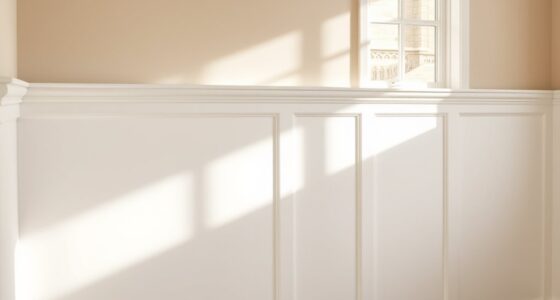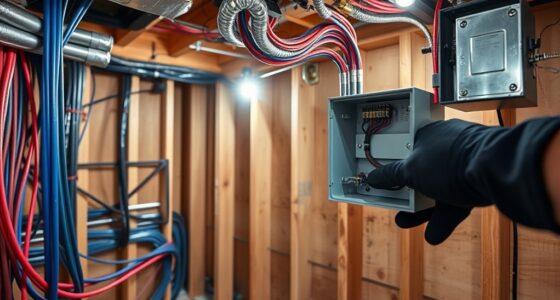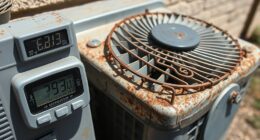When choosing between DIY floating and bracket shelves, consider your style and weight needs. Floating shelves give a sleek, modern look and hide supports, making your space feel more open. Bracket shelves are easier to install and support heavier items, adding character and versatility. Both styles can be customized with different materials. For tips on how to craft and install each type effectively, keep exploring these options to find the best fit for your space.
Key Takeaways
- Floating shelves provide a sleek, minimalist look but require precise installation and wall reinforcement for stability.
- Bracket shelves are easier to install, offering adjustable positioning and higher load capacity for heavier items.
- Floating shelves are ideal for decorative displays and small items, while brackets support more functional, heavy-duty storage.
- DIY floating shelves need careful wall embedding and hidden brackets, whereas bracket shelves can be assembled with visible supports.
- Both styles can be customized with various materials, but floating shelves maximize a clean, modern aesthetic.

Creating your own shelves is a practical way to organize your space while adding style. When choosing between floating and bracket shelves, you’ll find each offers unique advantages suited to different needs and aesthetics. Floating shelves create a “levitating” look by hiding the brackets inside the shelf itself. This design results in a sleek, minimalist appearance that works perfectly in modern or contemporary interiors. The clean lines and seamless look help maximize vertical space, making rooms feel larger and less cluttered. They’re especially popular in spaces that emphasize simplicity, like minimalist living rooms or bohemian bedrooms, where the focus is on uncluttered walls and subtle design. Floating shelves are also easier to clean because there are no exposed brackets or hardware to collect dust.
Floating shelves offer a sleek, minimalist look that maximizes space and reduces visual clutter.
Bracketed shelves, on the other hand, use visible supports that serve both functional and decorative roles. They come in various styles, from rustic wood to industrial metal, allowing you to introduce character and charm into your space. Because brackets are visible, you can choose different materials and finishes to match or contrast with your wall decor, giving you more stylistic flexibility. These shelves tend to be more versatile, fitting into a wider range of interior styles, including traditional, industrial, or eclectic. Their exposed supports also make them easier to install and adjust, as you can align brackets to ensure stability or aesthetic preference. If you anticipate changing your storage needs, bracketed shelves offer the convenience of repositioning without much hassle.
Installation differences are remarkable. Floating shelves require precise mounting inside the wall to hide the brackets, which can be moderately challenging. You’ll need to ensure the supports are embedded correctly into wall studs or reinforced for heavier loads. Once installed, they give a seamless, hardware-free appearance. Bracketed shelves are generally easier to install because the brackets can be mounted directly onto the wall or into studs, and they’re more forgiving if you need to reposition or adjust the shelf later. This makes them a good choice for DIYers who want straightforward, flexible installation.
In terms of strength, bracketed shelves usually support heavier loads because the brackets transfer weight directly to the wall. Metal brackets, in particular, provide greater load capacity than wooden or plastic ones. Floating shelves tend to support lighter to moderate weights unless reinforced, so they’re ideal for decorative objects, small books, or plants rather than large, heavy items. When customizing, floating shelves excel with options for various lengths, depths, and finishes, allowing you to tailor the setup to your space. Bracketed shelves offer a broad range of styles and materials, and you can easily change bracket positions to adapt to your evolving storage needs.
Both types of shelves enhance your room’s aesthetics and functionality. Your choice depends on your style preference, installation comfort, and load requirements. Whether you opt for the sleek, modern look of floating shelves or the character-rich appeal of bracketed supports, crafting your own shelving can transform your space with practicality and style.
Frequently Asked Questions
What Are the Best Materials for DIY Floating Shelves?
When choosing materials for your floating shelves, consider strength, durability, and aesthetics. Hardwood options like oak, maple, or walnut offer solid support and a beautiful finish, perfect for heavier loads. Engineered woods like MDF are budget-friendly, stable, and easy to paint or veneer. Plywood provides strength and versatility, while bamboo is eco-friendly. Match the material to your decor style and load needs for a sturdy, attractive result.
How Much Weight Can Bracket Shelves Typically Hold?
You’re wondering how much weight bracket shelves can hold. Typically, standard brackets support about 75 pounds each under ideal conditions, but heavy-duty brackets can handle up to 100 pounds or more. To maximize weight capacity, install brackets into wall studs using proper hardware, and guarantee your shelves are thick enough—around 1.75 to 2 inches. Distribute weight evenly, and regularly check for stability to keep your shelves safe and sturdy.
Are There Safety Concerns With DIY Floating Shelves?
When it comes to DIY floating shelves, safety shouldn’t be an afterthought—think of it as walking a tightrope. You need to guarantee they’re anchored into wall studs, not just drywall, and use heavy-duty hardware. Overloading them or placing them within reach of children can spell trouble. Proper installation, weight distribution, and considering the room’s use keep your shelves safe, sturdy, and a real asset rather than a hazard.
Can These Shelves Be Installed on Uneven Walls?
You can install shelves on uneven walls, but it requires careful planning. Use a stud finder to locate supports, and a level to ensure proper alignment. Shims and wall anchors help adapt to surface irregularities, preventing leaning or sagging. For floating shelves, ensure brackets have adjustment features, and for bracket shelves, drill accurately and utilize studs for support. Taking these steps guarantees a stable, visually appealing installation.
What Tools Are Essential for Installing Bracket Shelves?
Installing bracket shelves is like assembling a puzzle—you need the right tools to fit everything perfectly. You’ll want a drill with various bits to create pilot holes, a level to keep shelves straight, and a screwdriver for tightening screws. A tape measure helps you position brackets accurately, while a stud finder guarantees secure anchoring into wall studs. Don’t forget safety glasses and a pencil for marking precise spots before drilling.
Conclusion
Whether you choose floating or bracket shelves, DIY shelving can transform your space with style and functionality. Did you know that a well-organized room can boost your productivity by up to 25%? So, take the plunge and create your perfect storage solution. With the right tools and a bit of patience, you’ll enjoy both the process and the results—more space, better decor, and a sense of accomplishment. Happy building!









